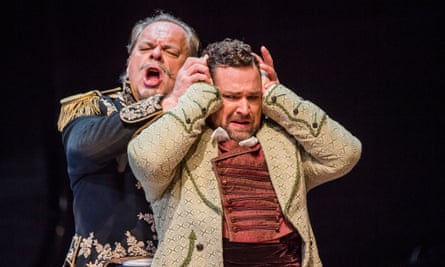There is – to risk sounding obtuse – an awful lot of opera in Stefan Herheim’s take on Verdi’s Les Vêpres Siciliennes. First seen in 2013 at the Royal Opera House, where it is now being revived under the directorial stewardship of Daniel Dooner, Herheim’s production returns the opera to the historical coordinates of its premiere: Paris, 1855, at the Opéra, then the world’s most prestigious venue for the art form.
Gesine Völlm’s costume designs see the heroine Hélène in the vast crinolines and near-spherical sleeves of historical portraits of the Second Empire court (they were Opéra regulars, of course). Philipp Fürhofer’s sets, meanwhile, constitute a rotating sequence of floor-to-ceiling lurid backdrops (a fiery volcano scene alternates with something a little more pastoral), a slice of full-size gilded auditorium populated by an on-stage audience, and a wall of mirrors complete with a barre, invoking the Opéra’s notorious foyer de la danse – a hotspot of institutionalised ogling, immortalised in paintings by Degas.
Animated by beautiful, sometimes breathtakingly subtle lighting by Anders Poll, this production is certainly saturated with the Opéra’s opulence. It’s also a restless, dance-filled staging with few of the moments of shock-and-awe stasis that are one of the hallmarks of Parisian grand opera. It’s hard, too, to say what all the self-consciously operatic gestures add up to: some of the more obvious symbolism quickly wears thin while elsewhere meaning remains irritatingly obscure.

Musically, though, there’s little equivocation. The first-night performance hit its stride in Act 2 and was excellent from then on. Driving from the pit, Maurizio Benini’s tempi were brisk, his pursuit of momentum a constant asset (if also an occasional danger, as stage and pit briefly parted ways in the evening’s early stages). Malin Byström was a dark-hued, hyper-authoritative Hélène, with an electrifying command of the role’s extravagant ornamentation and a bristling lower register. As her would-be lover Henri, Bryan Hymel served up his laser-like high notes as tirelessly as ever – no mean feat in a French opera of this vintage. Erwin Schrott was a fearsome Procida with apparently endless vocal power to burn and burnished legato to match.
But it was Michael Volle as Guy de Montfort, the plot’s troubled patriarch, whose performance stood out. Amid the production’s business and stream of operatic artifice, Volle’s rich, flexible baritone and captivating dramatic presence made for a remarkably sympathetic, remarkably human antihero.

Comments (…)
Sign in or create your Guardian account to join the discussion